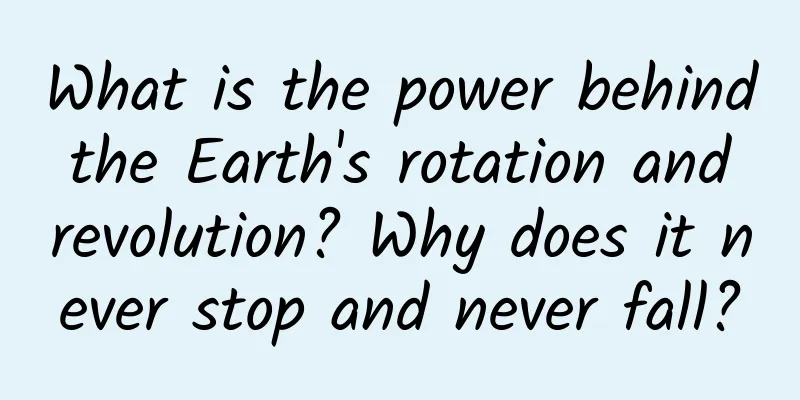What is the power behind the Earth's rotation and revolution? Why does it never stop and never fall?

|
This article is based on answering similar questions from netizens. First of all, movement is a natural law, there is no question of where it comes from. Modern science has long discovered that matter, no matter how big or small, from elementary particles, atoms and molecules that make up matter to planets, galaxies and nebulae, is in constant motion. These movements are controlled by four fundamental forces, namely gravity, electromagnetic force, strong force and weak force. Therefore, movement is a law of the universe. All celestial bodies rotate and revolve, and the earth is no exception. This is also a law, a law of the universe. Laws exist objectively, and humans cannot create or change them. They can only understand and use them. There is no question of why or where they come from. The first driving force of the universe is the Big Bang. From the Big Bang at a certain moment 13.8 billion years ago, the universe is still expanding. Modern theory believes that in addition to the first driving force, the game between dark matter and dark energy in the universe dominates the speed of galaxy contraction and expansion. Therefore, it is very complicated where the energy of cosmic motion comes from, and the movement of each particle is also very complicated. They are affected by the first mover, the four basic forces, and dark matter and dark energy. So where does the energy for the Earth's rotation come from? Now we use the principle of Occam's razor to shave off some non-main factors from the complex reasons and make it simple and clear. Then the Earth's rotation and revolution are mainly affected by gravity and the conservation of angular momentum. To understand this problem, we must start with the formation process of the earth. Stars are the most important component of visible matter in the universe, accounting for more than 90% of the mass of visible matter in the universe. Planets like the Earth, including dwarf planets, satellites, asteroids, comets, debris, etc., are all made up of the residue left after the formation of stars, accounting for a very small proportion. For example, in the solar system, the mass of the Sun alone accounts for 99.86% of the entire system, while the other eight planets, hundreds of small celestial bodies, and countless asteroid fragments together account for only 0.14% of the total mass. The mass of the Earth is only one 330,000th of the mass of the Sun, or 0.0003%. All stars are formed from huge nebulae, and the main force at work is gravity. The formation process has been described many times in previous articles, so I won't go into detail here. After the sun was formed, there was a planetary accretion disk around it, which has been retaining the angular momentum of the sun's formation process, that is, rotating around the sun. When the sun was first formed, it emitted strong radiation (also called stellar wind), which blew the matter in the accretion disk far away, so that the light matter was blown farther away and the heavy matter was closer to the sun. As a result, four denser terrestrial planets were formed around the sun, namely Mercury, Venus, Earth, and Mars; and four less dense gas planets were formed farther away from the sun, namely Jupiter, Saturn, Uranus, and Neptune. This accretion disk is today's ecliptic, and it is also the reason why celestial bodies such as planets in the solar system are mainly concentrated in the ecliptic. The direct cause of the Earth's revolution and rotation Under the influence of mutual gravity, the debris in the planetary disk collide and condense with each other, gradually condensing from the size of a fist to the size of a house. The larger it is, the stronger the attraction becomes, gradually becoming a sphere and absorbing all the debris around the orbit, thus a planet is formed. The Earth and all the planets were formed in this way. The Earth's revolution is inherited from the angular momentum of the accretion disk, that is, the speed at which it rotated in the past is the same as the speed at which it was formed. There are many theories about the formation of the Earth's rotation, mainly the impact theory, the equilibrium theory and the solar gravity theory. During the formation of the Earth, during the collision and adsorption of debris, it was impossible for the Earth to remain motionless and would gradually rotate. This was the initial stage of the Earth's rotation. After the Earth was initially formed, it collided with a planet about the size of Mars (scientists called it Theia), merging into a larger Earth, and the molten rock and debris from the collision flew into the sky and condensed into the Moon. This has been mentioned many times in the past, so I won’t elaborate on it. During these collisions, the Earth formed its current rotation angle and speed, which is the main source of the Earth’s rotation; and in order to maintain the stability of its orbit, the planet must also rotate, just like a gyroscope, which can only maintain balance by rotating. There is another theory that the Earth's rotation is caused by the gravitational pull of the Sun. This theory holds that the gravitational pull of the Sun pulls the side of the planet facing the Sun up (the influence of tidal force), and as the planet revolves, the position of this uplift changes, thereby forcibly driving the planet's rotation. The rotation of the earth is most likely caused by the combined influence of these forces. The basic property of matter, inertia, is the reason why the earth keeps rotating. The so-called inertia is the property of an object to maintain a state of rest or uniform linear motion, which is a basic property of matter. This theory states that any substance has inertia, which is the property of maintaining a certain state of motion or rest. As long as there is no external force, the object will always maintain a certain state. In space, there is a vacuum and no resistance. Therefore, once the earth and other celestial bodies form a certain state of motion, they will always maintain this state of motion without external forces. The same is true for the earth. Once its revolution and rotation are formed, they will continue unless there is an external force to change it. For example, the Earth will always move in a straight line at a given speed. However, due to the external force of the sun's gravity, the Earth cannot maintain uniform linear motion and tends to be pulled closer to the sun. However, the kinetic energy of its uniform linear motion always makes the Earth tend to escape the sun's gravity. These two forces form a balance, which results in the phenomenon of the Earth's revolution around the sun. The same is true for other planets. Therefore, the movement of the Earth in space is not completely without the influence of external forces. The gravity of the sun affects it all the time, so its revolution speed and rotation speed are constantly changing. This change is that the farther the Earth is from the sun, the slower its revolution and rotation speeds become. The speed of the Earth's revolution and rotation is constantly changing The overall trend of the Earth's rotation and revolution has been slowing down. The Earth is now about 150 million km away from the Sun, with an orbital speed of about 30 km/s, a rotational speed of 24 hours, and an equatorial speed of about 464 m/s. When the Earth was first born 4.6 billion years ago, it was closer to the Sun than it is now, so its rotational speed and orbital speed were faster. According to some scientific modeling, a day on Earth was only 4 hours 4.5 billion years ago, but it was extended to 8 hours 4 billion years ago, 18 hours 3 billion years ago, and 23 hours in the dinosaur era 6,500 years ago. Modern research has found that the Earth's rotation is still slowing down. One study suggests that the Earth's orbit has been slowly moving away from the Sun, reaching 1.5 cm (centimeter) per year, and its rotation is still slowing down, 1.6 milliseconds per 100 years. What does this mean? In 100 million years, the Earth will be 1,500 km away from the Sun, and the time per day will be extended by 1,600 seconds, or 26.7 minutes. The reasons for the longer orbit and slower rotation speed are very complicated. They are mainly caused by changes in gravity and the tidal forces of the sun and the moon on the earth. It is very complicated to explain these theories clearly, and I have talked about them many times in the past, so I will not elaborate on them. If you are interested, you can check out the related articles I have posted in the past. The above is the basis for the changes in the Earth's rotation and revolution. Why does the earth hang in the air and not fall? This is a joke, a question that is asked because of a complete lack of common sense about space. Simply put, there is no up-down, left-right relationship in the universe, so what is falling? We humans live on Earth, and it is because of gravity that we have the feeling of up and down, and the relative word "falling" appears. In the universe, there is only gravity, and there is no distinction between up and down, left and right. In a subsystem of the universe, it is mainly gravity that is at work, and the mutual gravitational force brings a group of celestial bodies together. For example, in the solar system, the sun is the largest celestial body, and its gravity plays a decisive role. All other celestial bodies revolve around the sun. But gravity is also interactive, and small celestial bodies will also have an effect on large celestial bodies. For example, the earth is not only affected by the sun's gravity, but also by the moon's tidal force. The moon is only 1/81 of the earth's mass, but it is precisely because of this satellite image that is much smaller than the earth that the earth's tides are larger. This is because the moon is close to the earth and its tidal force is 2.5 times that of the sun. If we talk about falling, it generally means that a small celestial body is pulled into the embrace of a large celestial body by the gravitational force of the large celestial body. For example, the Earth, in theory, can be pulled into the embrace of the Sun. However, since the Earth inherited the angular momentum of the planetary disk when it was formed, it has a tendency to escape the gravity of the Sun at a certain linear speed. The gravity and speed form a balance, so that the Earth can neither escape the gravity of the Sun nor be pulled over by the Sun. This is the orbital velocity, and all planets have this orbital velocity. As the distance increases, this velocity will automatically adjust. In this way, the Earth and other planets will orbit the Sun forever, until the Sun dies. Therefore, there is no concept of falling in space. Even if you fall onto the sun, you can say that you are sucked up or fall down, but you don't necessarily fall down. Do friends who have this question understand what I said? Thank you for reading and welcome to discuss. The copyright of Space-Time Communication is original. Infringement and plagiarism are unethical behavior. Please understand and cooperate. |
<<: Industrial 3D vision opens up new horizons for smart manufacturing
Recommend
2019 Sanba Ge Taobao no source single category blue ocean gameplay video tutorial Baidu network disk download
No source of goods means collecting and copying t...
Do you think they glow just for the sake of beauty? They are just "talking"!
Feng Weimin Bioluminescence is a fascinating phen...
Download the Beiyu Academy "Narrative Writing (Level 2): Writing Materials" from Baidu Cloud
Beiyu Academy's "Narrative Writing (Leve...
McLaren CEO: We have negotiated with Apple but no clear decision on acquisition
Recently, according to AutoBlog, as early as Sept...
Jack Ma couldn't stand it anymore and used Alipay to park and refuel Citroen C3 AIRCROSS
In 2017, the sales of Dongfeng Peugeot Citroen Au...
Life lies in stillness? A breakthrough in the secret of human blood clots lies in the hibernation of bears!
Although humans often regard themselves as the &q...
What is "lip rot"? Don't take it lightly!
Expert of this article: Wang Weibao, Endocrinolog...
Huawei Honor and Xiaomi are entering the US market: How difficult is it to survive?
Recently, as domestic mobile phone shipments have...
Bidding promotion: 6 secrets to high conversion!
A few days ago, someone chatted with me and said:...
8 promotion and monetization techniques, which one do you pick?
Today I will share with you the 8 most common mon...
Sony XB60 speakers - let life rock with music, let life be agitated with the rhythm
We often see in movies and TV shows that when our...
Be careful! If you see them, show zero tolerance!
Recently, the alligator gar in Ruzhou, Henan Prov...
[Live] Aihui Lu from Zego Technology: How to use Zego SDK to instantly build a real-time voice and video APP
[Original article from 51CTO.com] Online video li...
Shaoxing Real Estate Mini Program investment price inquiry, how much is the Shaoxing Real Estate Mini Program investment price?
How much does it cost to attract investment for S...
Do you have a special liking for poultry? Be careful of "parrot fever" knocking on your door! Here are some tips on how to prevent it~
Experts from Yiyang Central Hospital remind peopl...









